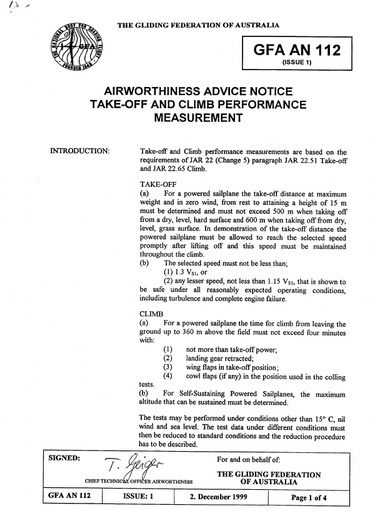pdf Gfa 112an Popular
By Tim Shirley Tagged in Various 892 downloads
gfa_112an.pdf

TAKE OFF AND CLIMB PERFORMANCE MEASUREMENT
Take-off and Climb performance measurements are based on the requirements of JAR 22 (Change 5) paragraph JAR 22.51 Take-off and JAR 22.65 Climb. TAKE-OFF (a) For a powered sailplane the take-off distance at maximum weight and in zero wind, from rest to attaining a height of 15 m must be determined and must not exceed 500 m when taking off from a dry, level, hard surface and 600 m when taking off from dry, level, grass surface. In demonstration of the take-off distance the powered sailplane must be allowed to reach the selected speed promptly after lifting off and this speed must be maintained throughout the climb. (b) The selected speed must not be less than; (1) 1.3 VS1, or (2) any lesser speed, not less than 1.15 VS1, that is shown to be safe under all reasonably expected operating conditions, including turbulence and complete engine failure. CLIMB (a) For a powered sailplane the time for climb from leaving the ground up to 360 m above the field must not exceed four minutes with: (1) not more than take-off power; (2) landing gear retracted; (3) wing flaps in take-off position; (4) cowl flaps (if any) in the position used in the colling tests. (b) For Self-Sustaining Powered Sailplanes, the maximum altitude that can be sustained must be determined. The tests may be performed under conditions other than 15° C, nil wind and sea level. The test data under different conditions must then be reduced to standard conditions and the reduction procedure has to be described.

